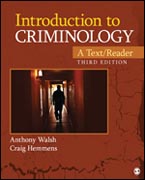
This popular text/reader provides instructors and students with the best of both worlds-authored text with carefully selected accompanying readings. Thoroughly updated throughout, this Third Edition provides an interdisciplinary perspective on crime and criminality that incorporates the latest theories, concepts, and research from sociology, psychology, genetics, evolutionary biology, and the neurosciences. INDICE: Section I. Introduction and Overview of Crime and Criminology Reading: The Use and Usefulness of Criminology, 1751-2005: Enlightened Justice and Its Failures by Lawrence W. ShermanSection II. Measuring Crime and Criminal Behavior Reading 2. Gender Gap Trends for Violent Crimes, 1980 to 2003: A UCR-NCVS Comparison by Darrell Steffensmeier, Hua Zhong, Jeff Ackerman, Jennifer Schwartz, and Suzanne Agha Reading 3. Methamphetamine Use, Self-Reported Violent Crime, and Recidivism Among Offenders in California Who Abuse Substances by Jerome Cartier, David Farabee, and Michael L. Prendergast Reading 4. Race and the Probability of Arrest by Stewart J. DAlessio and Lisa StolzenbergSection III. Victimology: Exploring the Experience of Victimization Reading 5. Violent Victimization as a Risk Factor for Violent Offending Among Juveniles by Jennifer N. Shaffer and R. Barry Ruback Reading 6. Age, Criminal Victimization, and Offending: Changing Relationships from Adolescence to Middle Adulthood by Scott MenardSection IV. The Early Schools of Criminology and Modern Counterparts Reading 7. An Introduction to the Principles of Morals and Legislation by Jeremy Bentham Reading 8. The Economics of Crime by Gary S. BeckerSection V. Social Structural Theories Reading 9. Community Correlates of Rural Youth Violence by D. Wayne Osgood and Jeff M. Chambers Reading 10. Social Structure and Anomie by Robert K. Merton Reading 11. Gangs and Social Change by Martin Sanchez-JankowskiSection VI. Social Process Theories Reading 12. Social Control in China: Applications of the Labeling Theory and the Reintegrative Shaming Theory by Xiaoming Chen Reading 13. Gender and Crime Among Felony Offenders: Assessing the Generality of Social Control and Differential Association Theories by Leanne Fiftal Alarid, Velmer S. Burton, Jr., and Francis T. CullenSection VII. Critical Theories: Marxist, Conflict, and Feminist Reading 14. Crime, Punishment, and the American Dream: Toward a Marxist Integration by Barbara A. Sims Reading 15. Patriarchy, Crime, and Justice: Feminist Criminology in an Era of Backlash by Meda Chesney-LindSection VIII. Psychosocial Theories: Individual Traits and Criminal Behavior Reading 16. Temperament, Environment, and Antisocial Behavior in a Population Sample of Preadolescent Boys and Girls by Rene Veenstra, Siegwart Lindenberg, Albertine J. Oldehinkel, Andrea F. De Winter, and Johan Ormel Reading 17. Psychopathy: Theory, Measurement, and Treatment by Anh Vien and Anthony R. BeechSection IX. Biosocial Approaches Reading 18. Neuroimaging Studies of Aggressive and Violent Behavior: Current Findings and Implications for Criminology and Criminal Justice by Jana L. Bufkin and Vickie R. Luttrell Reading 19. A Theory Explaining Biological Correlates of Criminality by Lee EllisReading 20. A Gene-Based Evolutionary Explanation for the Association Between Criminal Involvement and Number of Sex Partners by Kevin M. Beaver, John P. Wright, and Anthony Walsh Section X. Developmental Theories: From Delinquency to Crime to Desistance Reading 21. The Adolescence-Limited/Life-Course Persistent Theory of Antisocial Behavior: What Have We Learned? by Terrie E. Moffitt and Anthony Walsh Reading 22. A Life-Course View of the Development of Crime by Robert J. Sampson and John H. LaubSection XI. Violent Crimes Reading 23. Stick-Up, Street Culture, and Offender Motivation by Bruce A. Jacobs and Richard Wright Reading 24. Getting the Upper Hand: Scripts for Managing Victim Resistance in Carjackings by Heith Copes, Andy Hochstetler, and Michael CherbonneauSection XII. Multiple Murder and Terrorism Reading 25. African Americans and Serial Killing in the Media: The Myth and the Reality by Anthony Walsh Reading 26. The Terrorist Mind I: A Psychological and Political Analysis by Laurence MillerSection XIII. Property Crime Reading 27. Searching a Dwelling: Deterrence and the Undeterred Residential Burglar by Richard Wright Reading 28. The Novelty of Cybercrime: An Assessment in Light of Routine Activity Theory by Majid YarSection XIV. Public Order Crime Reading 29. Alcohol Problems and the Differentiation of Partner, Stranger, and General Violence by Rosemary Cogan and Bud C. Ballinger III Reading 30. The Association Between Multiple Drug Misuse and Crime by Trevor Bennett and Katy HollowaySection XV. White-Collar and Organized Crime Reading 31. Criminal Thinking and Identity in Male White-Collar Offenders by Glenn D. Walters and Matthew D. Geyer Reading 32. Examining the Role of Differential Association and Techniques of Neutralization in Explaining Corporate Crime by Nicole Leeper Piquero, Stephen G. Tibbetts, and Michael B. Blankenship Reading 33. The Causes of Organized Crime: Do Criminals Organize Around Opportunities for Crime or Do Criminal Opportunities Create New Offenders? by Jay S. AlbaneseGlossaryCredits and SourcesReferencesIndexAbout the Authors
- ISBN: 978-1-4522-5820-1
- Editorial: SAGE Publications, Inc
- Encuadernacion: Rústica
- Páginas: 640
- Fecha Publicación: 05/11/2013
- Nº Volúmenes: 1
- Idioma:
